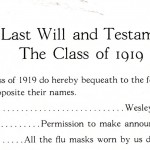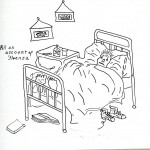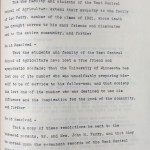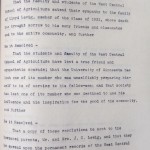We have taken you into our confidence before, regarding matters which have been of vital concern to the school and to you, and we find that you have always justified that confidence. Now we are once more opening our hearts and minds to you.
You know that the Spanish Influenza has swept over the world from one end to the other…
–Correspondence from WCSA Administration to Student Families, 19181West Central School of Agriculture Administration, WCSA Registrar to Student Parents and Guardians, Morris, MN, December 9, 1918, University Archives, Rodney A. Briggs Library, University of Minnesota, Morris, Morris, Minnesota.
By the fall of 1918, the war in Europe was winding down. The armistice that officially brought The Great War to an end was signed on November 11, 1918. The world, however, would not be at peace quite yet–as the war was coming to an end, the Spanish Influenza–a brutal pandemic that swept the world over–arrived in Minnesota in the fall of 1918.2From Peace and Prosperity to War and Nationalism: Stevens County and the War to End All Wars, (2014, Stevens County Historical Society), DVD. For American civilians who were separated from the fighting of the war by an ocean, the Spanish Influenza brought death to their front doors.
The first reported case of the flu in Morris was on October 11, 1918. By October 18, The West Central School of Agriculture, along with the rest of the city of Morris, was in a state of quarantine.3Ibid. The school was completely shut down on October 31 and students were sent back home.4WCSA to Parents, December 9, 1918. A new outbreak that was even worse arrived on November 22;5From Peace and Prosperity to War and Nationalism. the school had been scheduled to reopen on November 26 despite this new outbreak–the school cited that many students contracted the flu upon arriving home at the initial closing of the school, and that “our student body, therefore, will be practically immune to the disease, as physicians agreed that when one has had Spanish influenza, he will not take it again for some months.”6West Central School of Agriculture Administration, WCSA Superintendent to Student Parents and Guardians, Morris, Minnesota, November 21, 1918, University Archives, Rodney A. Briggs Library, University of Minnesota, Morris. Even still, a student fell ill on November 27.7 To ensure parents that their students were safe, the WCSA administration wrote to parents and guardians back home that skilled nurses were carefully attending to ill students around the clock and that physicians visited patients from one to three times a day, depending on the severity of the specific case.7WCSA to Parents, December 9, 1918. At this second outbreak, twelve cases of the Spanish Influenza ended up being reported at the West Central School of Agriculture.8Ibid. Pamphlets were released by the administration with information about flu symptoms and actions to take if such symptoms were discovered.9Influenza Symptoms and West Central School of Agriculture treatment notice, n.d., University Archives, Rodney A. Briggs Library, University of Minnesota-Morris, Morris, Minnesota. All in all, there was 12 weeks of banned activity in Stevens County as the flu spread its way around the area. Three WCSA students passed away as a result of the influenza and, in all, 116 students were infected with the virus.10“A History of the West Central School of Agriculture, Institute of Agriculture, University of Minnesota,” West Central School of Agriculture, Mocassin 1962 Yearbook: Volume 50, Golden Final Edition (Morris, MN, Graduating Class of 1962), 48, Stevens County Historical Society, Morris, Minnesota. Twenty-six students canceled school in the fall of 1918 because of the epidemic.11Registrars Report, 1918-1919, n.d, University Archives, Rodney A. Briggs Library, University of Minnesota, Morris, Morris, Minnesota. Although the campus did not suffer extensively in the amount of deaths it experienced, it still did not remain untouched by the influenza outbreak.
In wake of the flu, WCSA administrators put efforts towards figuring out how to make up for lost time during the quarantine. Credit hours and credit requirements were adjusted to ensure students could still graduate on time despite the setback of the influenza. When school resumed, students were given twice the workload to catch up on what they missed.
The 1919 Moccasin–which was the school yearbook–sheds an interesting light on student perceptions of the flu. Many cartoons and quips are found throughout the yearbook that make light of the influenza epidemic. Three examples of these can be found in the gallery below–click on the image to enlarge them. These cartoons and quips show that, despite how serious and dangerous the flu was, students were still able to look back on the difficult time with humor.
- “Earl Leaf…All the flu masks worn by us during the epidemic.”
- “All on account of ‘fluenza”
- “Perhaps his nose doesn’t fit the mask.”
By the beginning of 1919, the flu had all but disappeared from Stevens County. Even still, the school year had been drastically affected for WCSA students. Despite this, the WCSA students and administrators continued to look towards new goals. In 1919, with the creation of the French Orphan Committee, the WCSA began to assist in French Orphan Relief.12Gladys Goodnough, Report on French Orphan Relief Work, n.d, University Archives, Rodney A. Briggs Library, University of Minnesota, Morris, Morris, Minnesota. After the domestic scare of the Spanish Influenza had passed, WCSA students and staff again looked toward war-torn Europe for their volunteer efforts.
Below are copies of two resolutions sent out by the West Central School of Agriculture in memory of Lloyd Lewig and Leo Ferry, two of the WCSA students who died from the influenza. Lewig, a student from Nashua, Minnesota, became ill with the Influenza at home, while the school was closed; he relapsed when he returned to school. Ferry, from DeGraff, Minnesota, became sick two days after he returned to school to resume his studies.13Morris Tribune (Morris, MN), Dec. 13, 1918. Click on the images to enlarge them.
WCSA History–Buildings and Architecture–WCSA and the War
Image Citations:
1. “Last Will and Testament of the Class of 1919,” Mocassin 1919 Yearbook, (Morris, MN: Graduating Class of 1919, 1919), University Archives, Rodney A. Briggs Library, University of Minnesota-Morris, Morris, Minnesota.
2. “All on Account of ‘Fluenza,” Mocassin 1919 Yearbook, (Morris, MN: Graduating Class of 1919, 1919), University Archives, Rodney A. Briggs Library, University of Minnesota-Morris, Morris, Minnesota.
3. “Evelyn’s Wise Comment,” Mocassin 1919 Yearbook, (Morris, MN: Graduating Class of 1919, 1919), University Archives, Rodney A. Briggs Library, University of Minnesota-Morris, Morris, Minnesota.
4. “Resolution: In Memory of Leo Ferry,” Ledger Book of the West Central School of Agriculture 1918-1920, 1918, University Archives, Rodney A. Briggs Library, University of Minnesota, Morris.
5. “Resolution: In Memory of Lloyd Lewig,” Ledger Book of the West Central School of Agriculture 1918-1920, 1918, University Archives, Rodney A. Briggs Library, University of Minnesota, Morris.
References
| ↑1 | West Central School of Agriculture Administration, WCSA Registrar to Student Parents and Guardians, Morris, MN, December 9, 1918, University Archives, Rodney A. Briggs Library, University of Minnesota, Morris, Morris, Minnesota. |
|---|---|
| ↑2 | From Peace and Prosperity to War and Nationalism: Stevens County and the War to End All Wars, (2014, Stevens County Historical Society), DVD. |
| ↑3 | Ibid. |
| ↑4 | WCSA to Parents, December 9, 1918. |
| ↑5 | From Peace and Prosperity to War and Nationalism. |
| ↑6 | West Central School of Agriculture Administration, WCSA Superintendent to Student Parents and Guardians, Morris, Minnesota, November 21, 1918, University Archives, Rodney A. Briggs Library, University of Minnesota, Morris. |
| ↑7 | WCSA to Parents, December 9, 1918. |
| ↑8 | Ibid. |
| ↑9 | Influenza Symptoms and West Central School of Agriculture treatment notice, n.d., University Archives, Rodney A. Briggs Library, University of Minnesota-Morris, Morris, Minnesota. |
| ↑10 | “A History of the West Central School of Agriculture, Institute of Agriculture, University of Minnesota,” West Central School of Agriculture, Mocassin 1962 Yearbook: Volume 50, Golden Final Edition (Morris, MN, Graduating Class of 1962), 48, Stevens County Historical Society, Morris, Minnesota. |
| ↑11 | Registrars Report, 1918-1919, n.d, University Archives, Rodney A. Briggs Library, University of Minnesota, Morris, Morris, Minnesota. |
| ↑12 | Gladys Goodnough, Report on French Orphan Relief Work, n.d, University Archives, Rodney A. Briggs Library, University of Minnesota, Morris, Morris, Minnesota. |
| ↑13 | Morris Tribune (Morris, MN), Dec. 13, 1918. |




